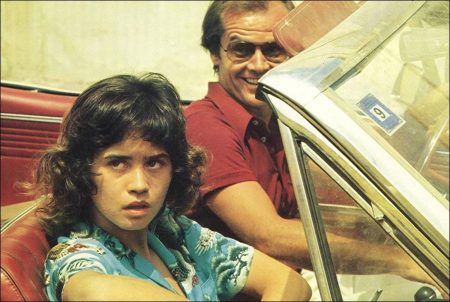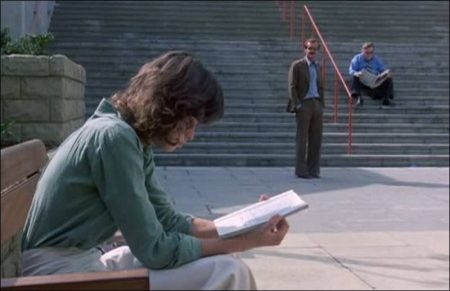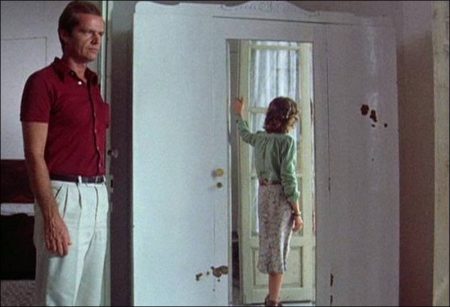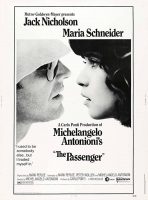Taglines: I used to be somebody else…but I traded him in.
Professione: Reporter movie storyline. David Locke (Jack Nicholson) is a reporter sent to the African deserts to report on activities there and discovers the dead body of an acquaintance, a man named Robertson. Seeking escape from his mundane life Locke takes on the identity of Robertson discovering many peculiar secrets of the dead man, one of which is that he is taking large amounts of money for supplying illegal arms to African terrorists.
Along the way Locke spots an attractive Girl (Maria Schneider) and strikes up a conversation with her. When Locke finds out that one of his old reporter friends, Martin Knight (Ian Hendry), is looking for Robertson to interview him, Locke gets the Girl to help him escape and they run away together. As the reporters and Locke’s wife close in with the Police, the man with the stolen identity realizes some serious facts about his life and its place in the world.
Professione: Reporter (English: The Passenger) is a 1975 drama neo noir art film directed by Michelangelo Antonioni. Written by Mark Peploe, Peter Wollen and Antonioni, the film is about an Anglo-American journalist, David Locke (Jack Nicholson) who assumes the identity of a dead businessman while working on a documentary in Chad, unaware that he is impersonating an arms dealer with connections to the rebels in the current civil war. Co-starring Maria Schneider, The Passenger was the final film in Antonioni’s three-picture deal with producer Carlo Ponti and Metro-Goldwyn-Mayer, after Blowup and Zabriskie Point, and competed for the Palme d’Or at the Cannes Film Festival.
About the Production
In a long take early in the film, Locke (Nicholson) is exchanging passport photos in his hotel room, with a tape recording playing an earlier conversation between Locke and Robertson, now dead. The camera pans, without a cut, to hold on Robertson’s now live appearance on the balcony, when Locke appears beside him and the two of them continue talking, i.e. an in-camera in-single-shot flashback.
The film’s penultimate shot is a seven-minute long take tracking shot which begins in Locke’s hotel room, looking out onto a dusty, run-down square, pushes out through the bars of the hotel window into the square, rotates 180 degrees, and finally tracks back to a close exterior view of the room’s interior.
The location of the hotel is stated to be Osuna in the film. However, the bullring at the edge of the square is recognisably that of the one in the Spanish town of Vera, in the province of Almería. In a DVD commentary, decades later, Nicholson said Antonioni built the entire hotel so as to get this shot.
Since the shot was continuous, it was not possible to adjust the lens aperture as the camera left the room and went into the square. Hence the footage had to be taken in the very late afternoon near dusk, in order to minimise the lighting contrast between the brightness outside and that in the room.
The square was windy and the crew needed stillness to ensure smooth camera movement. Antonioni tried putting the camera in a sphere so the wind might catch it less, but this would not fit through the window. In the scene, it appears that the bars may have been adjusted to be removed as the camera approached them.
The camera ran on a ceiling track in the hotel room and when it came outside the window, was meant to be picked up by a hook suspended from a giant crane nearly 30 metres high. A system of gyroscopes was fitted on the camera to steady it during the switch from this smooth indoor track to the crane outside. Meanwhile, the bars on the window had been given hinges. When the camera reached the window and the bars were no longer in the field of view, they were swung away to either side.
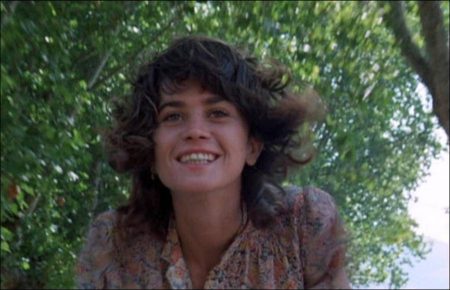
At this time the camera’s forward movement had to stop for a few seconds as the crane’s hook grabbed it and took over from the track. To hide this, the lens was slowly and smoothly zoomed until the crane could pull the camera forward. Then the cameraman walked the camera in a circle around the square, giving the crew time to shut the window bars before the camera returned to look through the window from the outside this time. Antonioni directed the scene from a van by means of monitors and microphones, talking to assistants who communicated his instructions to the actors and operators.
Although this is often referred to as the “final shot” of the film, there is one more. The last passage shows a small driving school car pulling away in the twilight, and the camera holds on the hotel as the film’s credits begin to roll.
Some years after the production ended, Nicholson had a dispute with Metro-Goldwyn-Mayer on an unrelated matter. The former had a deal with MGM in producing a film together, but when that project was not pursued, Nicholson demanded compensation; the result being the acquisition of this film. This explains why, out of the three arranged productions between Carlo Ponti and Michelangelo Antonioni for MGM beginning with Blowup (1966) and followed up by Zabriskie Point (1970); this was the only one not passed on to Warner Bros., successor-of-interest to the pre-1986 MGM catalogue via their acquisition of Turner Entertainment, who was the initial purchasor of said catalogue. For years Nicholson kept The Passenger out of circulation until Sony Pictures Classics courted him with an offer to restore the film.
Professione: Reporter (1975)
Directed by: Michelangelo Antonioni
Starring: Jack Nicholson, Maria Schneider, Steven Berkoff, Ian Hendry, Jenny Runacre, José María Caffarel, Miquel Bordoy, James Campbell, Ambroise Bia, Ángel del Pozo, Jaime Doria
Screenplay by: Mark Peploe, Michelangelo Antonioni, Peter Wollen
Production Design by: Lynn Kamern
Cinematography by: Luciano Tovoli
Film Editing by: Michelangelo Antonioni, Franco Arcalli
Costume Design by: Louise Stjernsward
Set Decoration by: Osvaldo Desideri
Art Direction by: Piero Poletto
Music by: Ivan Vandor
MPAA Rating: PG-13 for some violence, nudity and language.
Distributed by: United Artists
Release Date: February 28, 1975 (Italy), April 9 1975 (United States)
Visits: 101
